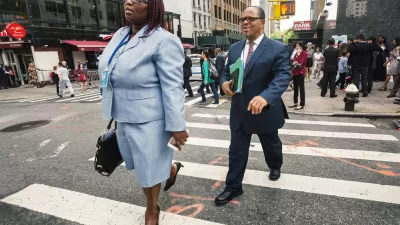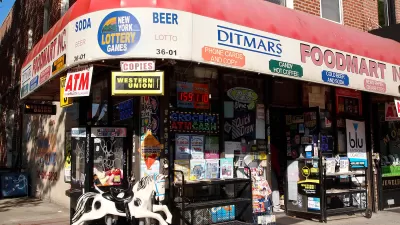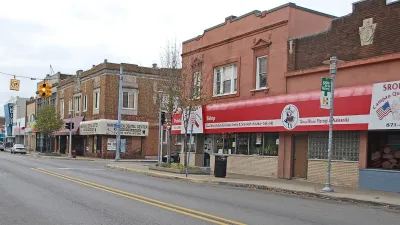Kaid Benfield proposes not only more walkable neighborhoods in the United States, where a pedestrian is struck by a vehicle every 7 minutes, but also more walking to reverse the country's alarming obesity trend.
In Woodbridge, Virginia, U.S. Route 1 looks like just another stretch of road in the country, says Benfield, but "[w]hat you don't see are any but the crudest accommodations for walking." The lack of crosswalks, sidewalks and traffic signals makes this corridor especially dangerous for pedestrians, and those who are hit by drivers are found at fault for "interfering with traffic" under Virginia law. Jay Mallin's Interfering with Traffic documents two men hit by vehicles while trying to cross the road on separate incidents near Route 1. They were charged for interfering with traffic, whereas the drivers were not charged at all. An even worse situation happened in Atlanta in 2011, where a single mother was convicted of homicide after her four-year-old son was killed by a driver under the influence.
"Even if you're not killed or injured, you can't help but find much of suburban American inhospitable to walking," laments Benfield. 13 percent of American children walked to school in 2006, compared to 60 percent in 1973. Laguna Beach refused to participate in International Walk to School Day, and in Montgomery County, Maryland, the local Department of Transportation denied parents' request for a crosswalk because "the safest way is to have them bused to school." Benfield asks, "If walking is no longer safe and convenient in relatively upscale Saratoga Springs and Laguna Beach, how are we going to fix a suburbanizing place whose residents may struggle to afford cars and arguably are even more in need of good alternatives? "
Jeff Speck's Walkable City offers a good start with his "ten steps of walkability" for urban environments, but many areas like the U.S. Route 1 in Woodbridge "are not the kind of prosperous communities where change can occur rapidly and with the degree of investment necessary to do it right." Although an approach still needs to be developed for these places, says Benfield, its imperative that Americans start walking more to reduce obesity and associated risks like heart disease, diabetes and premature death.
FULL STORY: The disturbing and sometimes tragic challenge of walking in America

Alabama: Trump Terminates Settlements for Black Communities Harmed By Raw Sewage
Trump deemed the landmark civil rights agreement “illegal DEI and environmental justice policy.”

Study: Maui’s Plan to Convert Vacation Rentals to Long-Term Housing Could Cause Nearly $1 Billion Economic Loss
The plan would reduce visitor accommodation by 25% resulting in 1,900 jobs lost.

Why Should We Subsidize Public Transportation?
Many public transit agencies face financial stress due to rising costs, declining fare revenue, and declining subsidies. Transit advocates must provide a strong business case for increasing public transit funding.

Wind Energy on the Rise Despite Federal Policy Reversal
The Trump administration is revoking federal support for renewable energy, but demand for new projects continues unabated.

Passengers Flock to Caltrain After Electrification
The new electric trains are running faster and more reliably, leading to strong ridership growth on the Bay Area rail system.

Texas Churches Rally Behind ‘Yes in God’s Back Yard’ Legislation
Religious leaders want the state to reduce zoning regulations to streamline leasing church-owned land to housing developers.
Urban Design for Planners 1: Software Tools
This six-course series explores essential urban design concepts using open source software and equips planners with the tools they need to participate fully in the urban design process.
Planning for Universal Design
Learn the tools for implementing Universal Design in planning regulations.
Caltrans
Smith Gee Studio
Institute for Housing and Urban Development Studies (IHS)
City of Grandview
Harvard GSD Executive Education
Toledo-Lucas County Plan Commissions
Salt Lake City
NYU Wagner Graduate School of Public Service





























